Ranks and insignia of the Russian armed forces until 1917
The Imperial Russian Army (Russian: Ру́сская импера́торская а́рмия, РИА) and the Imperial Russian Navy (Russian: Российский императорский флот) used ranks and rank insignia derived from the German model. However, the entire rank system was also closely connected to the Russian military traditions. In the aftermath of the Russian Revolution, the Red Army abolished the entire Imperial system of ranks and rank insignia, while military units and formations of the opposing White movement retained the Imperial rank system until 1923.
Army ranks and rank designation
The following ranks and their respective insignia were also used by the personnel of the Imperial Russian Air Servicefrom 1912 to 1917.
General officers
| designation | Commander-in-chief & higher commanders | |||||||
|---|---|---|---|---|---|---|---|---|
 |
 |
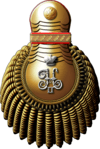 |
 |
 |
 | |||
| Rank insignia epaulettes and shoulder boards | ||||||||
| Rank | Generalfeldmarschall | General of the branch | Generalleutnant | Generalmajor | ||||
| Russian transliteration | General-feldmarshal | General roda voysk | General-leytenant | General-mayor | ||||
| Table of Ranks class |
K-1 | K-2 | K-3 | K-4 | ||||
Officers
| Designation | Field and junior grade officers | |||||||||
|---|---|---|---|---|---|---|---|---|---|---|
epaulette |
 |
 |
 |
 |
 |
 |
||||
| shoulder board |
 |
 |
 |
 |
 |
 |
 |
 | ||
| Rank | Polkovnik | Podpolkovnik | Major (abolished 1884) |
Captain | Staff-captain | Poruchik | Podporuchik | Praporshik | ||
| Russian transliteration | Полковник | Подполко́вник | Майор (abolished 1884) |
Капитан | Штабс-капитан | Пору́чик | Подпору́чик | Пра́порщик | ||
| Cavalry equivalent | Polkovnik | Podpolkovnik | Major (abolished 1884) |
Rittmeister | Staff-rittmeister | Poruchik | Kornet | - | ||
| Cossacks equivalent | Cossack colonel | Lieuetenant colonel (until 1884) Voyskovoy starshina (since 1884) |
Voyskovoy starshina (until 1884) |
Yesaul | Podyesaul | Sotnik | Khorunzhyi | - | ||
| Rank group | Stab-ofitsery (field officer ranks) | Ober-ofitsery (company officer ranks) | ||||||||
| Table of ranks class |
K-5 | K-6 | K-7 | K-8 | K-9 | K-10 | K-12 | K-13 | ||
Non-commissioned officers & enlisted men
| Designation | Non-commissioned officers & enlisted men (example boards- 1st Neva Infantry regiment) | ||||||||
|---|---|---|---|---|---|---|---|---|---|
 |
 |
 |
 |
 |
 |
 | |||
shoulder board | |||||||||
| Rank | Zauryad-praporshchik | Podpraporshchik | Feldwebel | Senior unteroffizier | Junior unteroffizier | Gefreiter | Private | ||
| Russian transliteration | ... | ... | Feldvevel | Starshy unter-ofitser | Mladshy unter-ofitser | Yefreytor | Ryadovoy | ||
| Cavalry | Zauryad-praporshchik | Podpraporshchik | Wachtmeister | Senior unteroffizier | Junior unteroffizier | Gefreiter | Uhlan | ||
| Cossacks | Podhorunzhiy | Wachtmeister | Warden | Junior unteroffizier | First cossack | Cossack | |||
| Artillery | Zauryad-praporshchik | Podpraporshchik | Feldwebel | Senior Feuerwerker | Junior Feuerwerker | Bombardier | Gunner | ||
| Rank group | Unter-ofitsery (NCOs) | Rydovye (enlisted men) | |||||||
Other regiments and cadet corps
The following shoulder board insignias of the Imperial Army used by specific units and cadet corps are illustrated below:
 Orenburg Neplyuev Cadet Corps
Orenburg Neplyuev Cadet Corps 15th King Nikola I of Montenegro Rifle Regiment
15th King Nikola I of Montenegro Rifle Regiment 5th Kargopol Dragoon Regiment
5th Kargopol Dragoon Regiment Oryol Cadet Corps
Oryol Cadet Corps.jpg) Pskov Cadet Corps
Pskov Cadet Corps Grand Duke Vladimir Kiev Cadet Corps
Grand Duke Vladimir Kiev Cadet Corps
Naval ranks and rank insignia
The Imperial Russian Navy () of the Russian Empire, had been established at the end of the 17th century under the regency of Peter the Great and by the personal leadership of Franz Lefort. It existed until the October Revolution of 1917.[1]
| Rank, category and designation | Flag officers and general ranks | Staff officers (Russian: Shtabs-ofitsery) | Senior officers (ober-ofitsery) | |||||||||
|---|---|---|---|---|---|---|---|---|---|---|---|---|
| Class as to Table of Ranks | K1 | K2 | K3 | K4 | K6 | K7 | K8 | K9 | K10 | |||
| Epaulette | Maritime service |
Generaladmiral (General-admiral) |
Admiral | Viceadmiral (Vitse-admiral) |
Rear admiral (Kontr-admiral) |
Captain (Navy) (Kapitan 1-go ranga) |
Commander (Kapitan 2-go ranga) |
Lieutenant commander (1907-1911) (Kapitan-leytenant) |
Lieutenant (naval) (after 1909) (Starshi leytenant) |
Sub-lieutenant (Leytenant) |
Michman | |
| (after 1909) | (until 1909) | |||||||||||
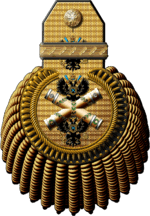 |
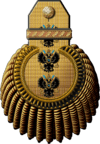 |
 |
 |
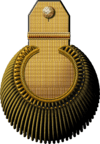 |
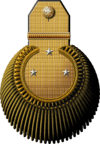 |
 |
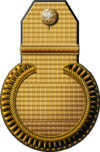 |
 |
 |
 | ||
| Shore Establishment (after 1913) |
no equivalent | General | Lieutenant general (General-leytenant) | Major general (General-mayor) | ||||||||
 |
 |
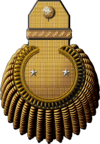 | ||||||||||
| Shoulder board |
Maritime service |
Generaladmiral (General-admiral) |
Admiral | Viceadmiral (Vitse-admiral) |
Rear admiral (Kontr-admiral) |
 |
 |
 |
 |
 |
 |
 |
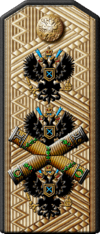 |
 |
 |
 | |||||||||
| Shore establishment (after 1913) |
no equivalent | General | Lieutenant general (General-leytenant) |
Major general (General-mayor) | ||||||||
 |  |  | ||||||||||
Non-commissioned officers & enlisted ratings, naval services
| Designation | Petty officers & enlisted ratings | |||||||
|---|---|---|---|---|---|---|---|---|
 |
 |
 |
 |
 |
 |
 |
 | |
| Rating insignia shoulder boards | ||||||||
| Rating insignia | Gardemarin (abolished 1883) |
Senior boatswain |
Conductor Senior (army) field surgeon |
Boatswain | Coxswain | Unteroffizier (since 1909) Quartermaster (until 1908) | Seaman 1st rank | Seaman 2nd rank |
| Russian transliteration | (Gardmarin) | (Starshy botsman) | (Konduktor Starshy feldsher) |
(Botsman) | (Botsmanmat) | (Unter-ofizer Kwartirmeister) |
(Matros pervoi stati) | (Matros vtoroi stati) |
Ranks of coastal services
Ranks similar to those of the Imperial Army were, beginning in the late 18th century, used by the coastal services of the Imperial Russian Navy.
General officers
| Designation | Higher commanders | |||||
|---|---|---|---|---|---|---|
Rank designation epaulettes and shoulder boards |
 |
 |
 |
 |
 |
 |
| Rank | General of the fleet | Lieutenant general | Major general | |||
| Russian transliteration | (Флота генерал) (Flota general) |
(Генера́л-лейтена́нт) (General-leitenant) |
(Генера́л-майо́р) (General-maior) | |||
Officers
| Designation | Field and junior grade officers | ||||||||||||
|---|---|---|---|---|---|---|---|---|---|---|---|---|---|
 |
 |
 |
 |
 |
 |
 |
 |
 |
 |
 | |||
| Rank insignia epaulettes and shoulder boards | |||||||||||||
| Rank | Brigadier (abolished 1798) |
Colonel | Lieutenant colonel | Major (abolished 1884) |
Captain | Staff captain | Lieutenant | Sub-lieutenant | Ensign | ||||
| Russian transliteration | Brigadir | Polkovnik | Podpolkovnik | Mayor | Kapitan | Shtabs-kapitan | Poruchik | Podporuchik | Praporshchik | ||||
| Rank group | Staff officer | Junior officer | |||||||||||
Non-commissioned officers & enlisted men
| Designation | Non-commissioned officers & enlisted men | ||||||||
|---|---|---|---|---|---|---|---|---|---|
 |
 |
 |
 |
 |
 | ||||
| Rank insignia shoulder strap | |||||||||
| Rank | Warrant officer (1855-1917) |
Bootsman | Senior under officer | Junior under officer | Sea gefreiter | Sea soldat | |||
| Russian translation | (Старший боцман, кондуктор) | (Боцман) | (Старший унтер-офицер, starschy unter-ofizer) |
(Младший унтер-офицер, mladschy unter-ofizer) |
(Матрос 1-й статьи, Matros 1 statji) |
(Матрос 2-й статьи, Matros 2 statji) | |||
| Rank group | NCO | Soldier | |||||||
Sleeve insignia of the Russian Navy from April 16, 1917
By order № 125 of the Navy Ministry of the Russian Provisional Government, from April 16, 1917 was provided:
- Abolishment of the hitherto used shoulder rank insignia
- Abolishment of the (naval)scarf
- Deletion of any monogram, or initial letter on weapons and equipment
- Paint over of the cockade center on caps with red color, until availability of the peaked cap with new national emblem
The traditional shoulder rank insignia were replaced by golden sleeve strips for naval officers, admiralty officers, and naval engineers, as well as – after completion of mandatory examinations – praporshchiks and officers of the hydrographical service.
Silver sleeve strips were introduced to officers of the admiralty staff, before completion of mandatory examinations, as well to ship engineers, officials of the naval administration and naval physicians with officer rank or status.
Both cuff insignias were used in uniforms with the executive curl.
As discrimination criteria to specific appointments or assignments additional corps colours on the lower part of sleeve stripes was determinate:
- red = ship engineers;
- raspberry coloured = naval administration;
- dark blue = hydrographical service;
- white = physicians
The table below shows examples of rank insignia of the Russian Navy, to be worn on the lower part of uniform cuffs, as to the order № 125 of the Russian Navy Ministry from April 16, 1917.
| Designation | Gold sleeve strips to naval officers | ... hydrographical service | ||||||||
|---|---|---|---|---|---|---|---|---|---|---|
Sleeve insignia |
 |
 |
 |
 |
 |
 |
 |
 |
 |
 |
| Rank | Admiral | Vice admiral | Rear admiral | Captain 1st rank (Captain naval) |
Captain 2nd rank (Commander) |
Senior lieutenant (lieutenant commander) |
Lieutenant (naval) | Michman | Podporuchik | Praporshchik |
| Russian transliteration | (Admiral) | (Vitse-admiral) | (Kontr-admiral) | (Kapitan 1-go ranga) | (Kapitan 2-go ranga) | (Starshy leytenant) | (Leytenant) | |||
| Class (as specified in the Table of Ranks) |
Admiral ranks | Shtab-ofitsery (Staff officers) | Ober-offitsery (upper officers) | |||||||
| K-2 | K-3 | K-4 | K-6 | K-7 | K-8 | K-9 | K-10 | K-12 | K-14 | |
See also
- History of Russian military ranks
- Ranks and insignia of the Red Army and Navy 1918–1935, ... 1935–1940, and ... 1940–1943
- Ranks and insignia of the Soviet Armed Forces 1943–1955 and ... 1955–1991
- Ranks and rank insignia of the Russian Federation´s armed forces 1994–2010
- Army ranks and insignia of the Russian Federation and Naval ranks and insignia of the Russian Federation for the current ranks
References
- Erich Donnert: Peter the Great (de: Peter der Große), Koehler & Amelang, Leipzig, page. 130